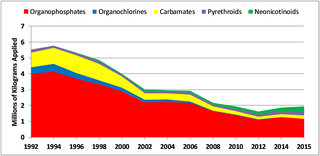PLOS Biology ( IF 7.8 ) Pub Date : 2017-12-21 , DOI: 10.1371/journal.pbio.2004741 Robert B. Gunier , Asa Bradman , Kim G. Harley , Brenda Eskenazi

|
California has proposed limiting agricultural pesticide use within 0.4 km of schools and childcare facilities. However, the 0.4-km buffer may not be appropriate for all pesticides because of differing toxicities, fate, and application methods. Living near pesticide use has been associated with poorer birth outcomes, neurodevelopment, and respiratory function in children. More research about exposures in schools, childcare facilities, and homes is needed. Despite incomplete science, this regulation is an important step to reduce potential exposures to children. The most vulnerable exposure period may be in utero, and future regulations should also aim to reduce exposures to pregnant women.
中文翻译:

农业地区学校周围的缓冲区是否足以保护儿童免受农药暴露的潜在不利影响?
加利福尼亚州提议限制在学校和儿童保育设施的0.4公里内使用农业杀虫剂。但是,由于毒性,命运和施用方法的不同,0.4 km的缓冲液可能不适用于所有农药。靠近农药使用生活与儿童较差的出生结局,神经发育和呼吸功能有关。需要对学校,儿童保育设施和房屋中的暴露进行更多研究。尽管科学不完善,但这项法规还是减少儿童潜在暴露的重要一步。最脆弱的暴露期可能在子宫内,未来的法规还应旨在减少孕妇的暴露。











































 京公网安备 11010802027423号
京公网安备 11010802027423号